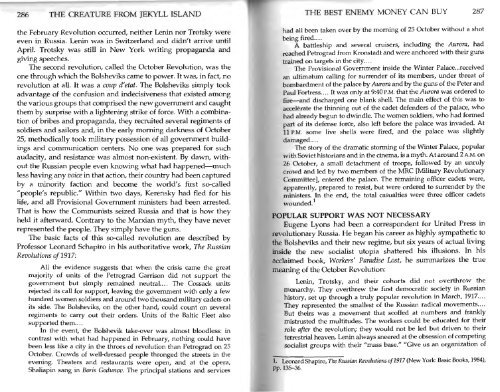Create successful ePaper yourself
Turn your PDF publications into a flip-book with our unique Google optimized e-Paper software.
286 THE CREATURE FROM JEKYLL ISLAND THE BEST ENEMY MONEY CAN BUY 287<br />
the February Revolution occurred, neither Lenin nor Trotsky were<br />
even in Russia. Lenin was in Switzerland and didn't arrive until<br />
April. Trotsky was still in New York writing propaganda and<br />
giving speeches.<br />
The second revolution, called the October Revolution, was the<br />
one through which the Bolsheviks came to power. It was, in fact, no<br />
revolution at all. It was a coup d'etat. The Bolsheviks simply took<br />
advantage of the confusion and indecisiveness that existed among<br />
the various groups that comprised the new government and caught<br />
them by surprise with a lightening strike of force. With a combination<br />
of bribes and propaganda, they recruited several regiments of<br />
soldiers and sailors and, in the early morning darkness of October<br />
25, methodically took military possession of all government buildings<br />
and communication centers. No one was prepared for such<br />
audacity, and resistance was almost non-existent. By dawn, without<br />
the Russian people even knowing what had happened—much<br />
less having any voice in that action, their country had been captured<br />
by a minority faction and become the world's first so-called<br />
"people's republic." Within two days, Kerensky had fled for his<br />
life, and all Provisional Government ministers had been arrested.<br />
That is<br />
how the Communists seized Russia and that is how they<br />
held it afterward. Contrary to the Marxian myth, they have never<br />
represented the people. They simply have the guns.<br />
The basic facts of this so-called revolution are described by<br />
Professor Leonard Schapiro in his authoritative work, The Russian<br />
Revolutions of 1917:<br />
All the evidence suggests that when the crisis came the great<br />
majority of units of the Petrograd Garrison did not support the<br />
government but simply remained neutral.... The Cossack units<br />
rejected its call for support, leaving the government with only a few<br />
hundred women soldiers and around two thousand military cadets on<br />
its<br />
side. The Bolsheviks, on the other hand, could count on several<br />
regiments to carry out their orders. Units of the Baltic Fleet also<br />
supported them.. .<br />
In the event, the Bolshevik take-over was almost bloodless: in<br />
contrast with what had happened in February, nothing could have<br />
been less like a city in the throes of revolution than Petrograd on 25<br />
October. Crowds of well-dressed people thronged the streets in the<br />
evening. Theaters and restaurants were open, and at the opera,<br />
Shaliapin sang in Boris Godunov. The principal stations and services<br />
had all been taken over by the morning of 25 October without a shot<br />
being fired....<br />
A battleship and several cruisers, including the Aurora, had<br />
reached Petrograd from Kronstadt and were anchored with their guns<br />
trained on targets in the city.. .<br />
The Provisional Government inside the Winter Palace...received<br />
an ultimatum calling for surrender of its members, under threat of<br />
bombardment of the palace by Aurora and by the guns of the Peter and<br />
Paul Fortress. ...<br />
It was only at 9:40 P.M. that the Aurora was ordered to<br />
fire—and discharged one blank shell. The main effect of this was to<br />
accelerate the thinning out of the cadet defenders of the palace, who<br />
had already begun to dwindle. The women soldiers, who had formed<br />
part of its defense force, also left before the palace was invaded. At<br />
11P.M. some live shells were fired, and the palace was slightly<br />
damaged., .<br />
The story of the dramatic storming of the Winter Palace, popular<br />
with Soviet historians and in the cinema, is a myth. At around 2 A.M. on<br />
26 October, a small detachment of troops, followed by an unruly<br />
crowd and led by two members of the MRC [Military Revolutionary<br />
Committee], entered the palace. The remaining officer cadets were,<br />
apparently, prepared to resist, but were ordered to surrender by the<br />
ministers. In the end, the total casualties were three officer cadets<br />
wounded.<br />
POPULAR SUPPORT WAS NOT NECESSARY<br />
Eugene Lyons had been a correspondent for United Press in<br />
revolutionary Russia. He began his career as highly sympathetic to<br />
the Bolsheviks and their new regime, but six years of actual living<br />
inside the new socialist Utopia shattered his illusions. In his<br />
acclaimed book, Workers' Paradise host, he summarizes the true<br />
meaning of the October Revolution:<br />
Lenin, Trotsky, and their cohorts did not overthrow the<br />
monarchy. They overthrew the first democratic society in Russian<br />
history, set up through a truly popular revolution in March, 1917....<br />
They represented the smallest of the Russian radical movements....<br />
But theirs was a movement that scoffed at numbers and frankly<br />
mistrusted the multitudes. The workers could be educated for their<br />
role after the revolution; they would not be led but driven to their<br />
terrestrial heaven. Lenin always sneered at the obsession of competing<br />
socialist groups with their "mass base." "Give us an organization of<br />
& Leonard Shapiro, The Russian Revolutions ofl917 (New York: Basic Books, 1984),<br />
pp. 135-36.


